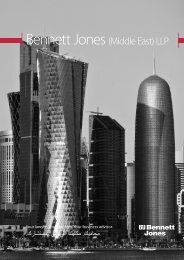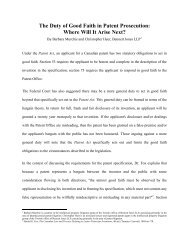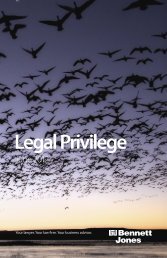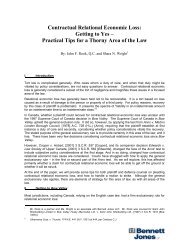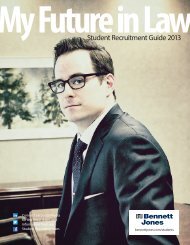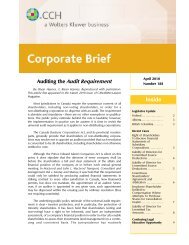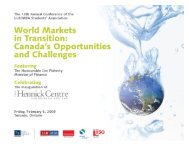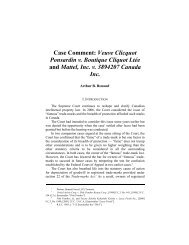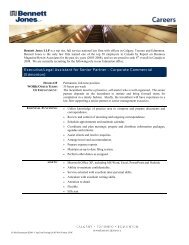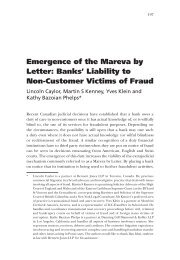PONZI SCHEMES (AND OTHER REALLY BAD ... - Bennett Jones
PONZI SCHEMES (AND OTHER REALLY BAD ... - Bennett Jones
PONZI SCHEMES (AND OTHER REALLY BAD ... - Bennett Jones
- No tags were found...
Create successful ePaper yourself
Turn your PDF publications into a flip-book with our unique Google optimized e-Paper software.
<strong>PONZI</strong> <strong>SCHEMES</strong> (<strong>AND</strong> <strong>OTHER</strong> <strong>REALLY</strong> <strong>BAD</strong> INVESTMENTS) –<strong>AND</strong> WHAT TO DO ABOUT THEMBlair C. Yorke-Slader 1Carlo Ponzi was 21 years old and had $2.50 in his pocket when he arrived in Boston from Lugo,Italy in 1903. He drifted to Montreal in 1908, where he was imprisoned for forgery. He was jailed until 1911,when he returned to Boston to work as a dishwasher.In 1919, Ponzi started the Securities Exchange Company to promote International Postal ReplyCoupons, a legitimate product which allowed someone in one country to prepay the postage of a reply letterfrom another. Aunt Millie could buy a coupon and send it overseas to her favourite niece Betsy, who coulduse it to pay to post her own letter back. The coupons were priced in the country of purchase, and thenredeemed in the country of use. Post-war inflation had created an arbitrage opportunity in the coupons,allowing Ponzi to claim that he could thereby generate very high rates of return. He set about findinginvestors for his purported arbitrage scheme, and paid generous commissions to agents who found them forhim.Money poured in from all over New England. Ponzi promised 50% interest on investments in 45days, or "double your money" in 90. Most investors, thrilled with their great reported returns, did not takeprofits but instead reinvested everything. Many more joined in. Ponzi made no effort to generate legitimateprofits; he simply used the new investors' money to pay (or at least to "credit") the existing investors. By1 In the preparation of this paper, I am deeply indebted to my law partners Munaf Mohamed and Mike Mysak, two key members of the <strong>Bennett</strong> <strong>Jones</strong>Fraud Law Practice Group. They regularly represent investors and financial institutions in chasing down bad guys who operate ponzi schemes andother frauds. On this occasion, as on all occasions on which they invite me to join in what is far more frequently their area of practice than mine,they have been generous in sharing their experience, modest in sharing their wisdom, and tactful in sharing their constructive criticism. Theirconsiderable contributions have, I hope, permitted me to preserve the illusion of considerably more expertise than I really have.
- 2 -July 1920 he was bringing in $250,000 a day through 35 offices. In all, almost 40,000 people invested atotal of about $15 million (approximately $165 million in today's dollars).Clarence Barron, the publisher of Barron's, investigated. He discovered that, just to cover theinvestments made with Ponzi, 160 million postal reply coupons would have to be in circulation. About27,000 actually were. Ponzi, it turned out, had purchased only about $30 worth.Ponzi was arrested, charged with fraud, and convicted. He served a total of 12 years in federal andstate prisons. His investors ultimately recovered less than 30 cents on the dollar. Ponzi died in Brazil in1949, destitute, but his name has lived on in infamy."Ponzi schemes", as they have come to be known, are merely one of many kinds of securities fraud– essentially the marketing to unsuspecting investors of a debt or equity instrument which is not what it isrepresented to be. Securities fraud is really just a form of theft – taking people's money in return for a pieceof paper which is of essentially no value. 2My father used to describe dubious mining claims as "moosepasture", and of course there have been a number of contemporary examples of that – Bre-X, Cartaway andGolden Rule, to name a few.What was striking about Bre-X and similar cases was that the frauds were committed in plain viewof the regulators, in a sophisticated public market. Fundamentally, though, the represented assets did notexist, so the paper reflecting ownership in them was worthless.2 The old legend of selling ownership of the Brooklyn Bridge is an easy example.
- 3 -By contrast, ponzi schemes do pay off, at least at first. As children we may have become involvedin chain letters (the payoff of which was simply the satisfaction of believing that millions of people receivedyour letter), and later the $5 or "sleeve of golf balls" versions thereof. A big part of the allure of suchschemes is that they offer strikingly high rates of return which are actually paid for a while. People whohave the good fortune to get in early can actually win, if they can resist the temptation to invest more thantheir original stake.Ponzi schemes are not necessarily pyramid schemes. While their principals often use others togather investors, and reward them on a commission basis, a ponzi scheme does not require a multi-levelmarketing strategy, where aggregators are compensated with a percentage of the investment monies ofthose they recruit. Put simply, a ponzi scheme is an exercise of robbing Peter to pay Paul 3 – later investors'money is used to pay returns to earlier investors. Such schemes succeed because, after some minor initialapparent success, investors are usually persuaded to reinvest their money, and often to increase the extentof their participation.In the decades after Ponzi, there were various similar schemes, including in the 1980s the SouthAfrican "Kubus" scheme (milk cultures for beauty products), the Michigan-based Diamond MortgageCompany, and J. David Dominelli's supposed commodity and currency trading operation in California. In thelast twenty years or so, many more such schemes have come to light around the globe, involving in total3 Modern wisdom is that this expression refers to the use of funds of money from Westminster Abbey (The Collegiate Church of St. Peter) to pay forthe completion of construction of St. Paul's Cathedral, but it seems to date from a time before the Reformation when taxes had to be paid both to St.Paul's Church in London and to St. Peter's Church in Rome, and the latter were sometimes neglected in order to pay the former. The sayingappears in John Wycliffe's "Select English Works" (c. 1380), and may derive from a 12 th century Latin expression, "Tanquam si quis CrucifigerPaulum ut redimeret Petrum". (As it were that one would crucify Paul in order to redeem Peter).
- 4 -billions of dollars – in Russia, Romania, Germany, Haiti, Britain, the Philippines, Pakistan, Malaysia, CostaRica, Albania, India, and of course various based in the United States and Canada.Recently, there has seemingly been an even greater proliferation of promoters of such schemes,including Bernie Madoff, Allen Stanford and Barry Tannenbaum, not to mention our own Canadian rogues'gallery – Earl <strong>Jones</strong>, Vincent Lacroix, Weizhen Tang (the "Chinese Warren Buffett") and now, it seems,Albertans Milowe Brost and Gary Sorenson and their Institute for Financial Learning ("IFFL")/StrategicMetals ventures.Why do ponzi schemes work, and why do we seem to have had a recent rash of them? Greed, agood story, and conspicuous wealth, I suppose. In Alberta, for example, robust economic success hascreated a great number of people with new money to invest. The Brost/Sorenson scheme was marketed inpart to professional football players, many of them living far away from home and earning some real moneyfor the first time. For investors such as these, the stock market can be a scary place, akin to visiting thecasino.By contrast, Ponzi structures are often affinity schemes – based initially on trusted family, church orcommunity relationships. Would-be investors see their friends, family or neighbours apparently making easymoney with little effort. Many initial investors are often themselves innocent of the fraudulent nature of theinvestment scheme, and of course are entirely trustworthy in the eyes of their friends, family and neighbourswith whom they delightedly offer to share their exciting new opportunity for quick and easy financial success.
- 5 -The tragedy is that a true ponzi scheme is, by definition, insolvent. 4Unlike simple fraud, where thefraudster takes your money and goes to (say) Honduras, a ponzi scheme pays out much of the investors'money to people who got in earlier, either to keep them from demanding their principal back or to get themto invest more. Sure, the fraudsters generally use some of the money to support opulent lifestyles, but mostgets ploughed back. Bernie Madoff constructed fake stock portfolios, but there is no evidence that he everbought a single security for his clients. In a scheme such as his, which operated for something like 20years, it is inescapable that many early investors profited and got out before the scheme imploded as equitymarkets ultimately fell, as inevitably they ultimately would. 5At the less culpable end of the scale is the sort of investment which may have started out inperfectly good faith, as a legitimate investment, but in which the pressure to maintain returns to investors asthe economy soured caused promoters to start using fresh investment funds simply to pay promised orexpected distributions to the existing investors.For a very recent example of this, we need look no further than Concrete Equities. The Calgarybasedreal estate syndicator undeniably had a real product – units in limited partnerships which owned realdowntown office buildings. A supposed investment in "land" can seem especially secure (although ofcourse a real estate limited partnership interest is not really an interest in land; it is merely part ownership ofan entity which owns the land, often in a trust structure where the promoter controls the trust). The Alberta4 See Titan Investments Ltd. Partnership (Re), 2005 ABQB 637, per Hawco J. at paras. 8 and 16.5 Madoff family members are alleged to have received almost $200 million in preferential returns, and Hadassah, a charity known best for buildinghospitals in Israel, supposedly received more than $130 million.
- 6 -Securities Commission took jurisdiction over these interests a number of years ago, 6 so at least they aresupposed to involve an offering memorandum, or other materials in compliance with the Securities Act, 7butthere are still lots of promoters who do not comply. Even if they do comply, there is typically no liquidmarket in which to trade the investments, so there is often no real ongoing scrutiny by the regulator.Seemingly Concrete complied with all appropriate statutory requirements, but then it baseddistributions to its investors on the returns promised in its promotional materials rather than the actualdistributable cash from the buildings. In the case of its namesake property Concrete Equities Place, forexample, investors received distributions for four months prior to the date of their limited partnership'spurchase of the building. Where did the excess cash come from? From other people's subscription moniesor other properties' excess cash flow, of course, 8 – robbing Peter to pay Paul.The Brost/Sorenson and Concrete stories follow on the heels of a less known Alberta-basedscheme which operated across North America until the spring of 2007, known as Front Row Tickets. FrontRow was premised on an online ticket brokerage operation (the old fashioned description would be scalping,but in the internet age the business is now apparently respectable). Investors were told that Front Row,suitably financed, could purchase tickets to sporting and other entertainment events in bulk, and then resellthem promptly at a large profit. Funds were "loaned" by the investors to Front Row for such purpose, withthe promise of returns often exceeding 75% per year.6 In the matter of The Land Development Company Inc. and Phil Archer, [2002] A.S.C.D. No. 468.7 R.S.A. 2000, c. S-4, as amended.8 In the matter of Concrete Equities Inc., Court of Queen's Bench of Alberta Action No. 0901-11048, Third Report of the Monitor (anticipated to bepublished shortly after the publication of this paper).
- 7 -Some tickets were in fact purchased and resold, and the ticket brokerage website was real. Farmore money was raised, however, than ever went to buy tickets – the vast majority of it was, it seems,simply used to run a ponzi scheme. 9Eventually the scheme collapsed; while the resulting litigation has notconcluded, it seems likely that investors will recover no more than a fraction of their invested funds.Technically, one of the legal remedies available in respect of such schemes is the appointment of areceiver to trace all monies and to attempt to recover those paid out to (presumably innocent) earlierinvestors. In the United States, where the law expressly provides for such claims, "clawback" lawsuits arecommonly launched against earlier investors. The trustee of Madoff's firm issued over two hundreddemands for repayment, and recovery lawsuits have now been initiated as well. 10Often, though, records are poor, making the tracing exercise difficult, or investors simply have noappetite to take action against others who were merely luckier to get in (and, more importantly, out) earlierthan they were. In the Front Row Tickets example, while court orders were obtained to freeze what thescheme had in hand, and the principals were chased down for further funds, still the recovery was modest.Most of the money raised had seemingly gone back out to pay high promised rates of return to earlierinvestors, and the ultimate victims were disinclined to sue them, regarding them as victims of the scheme aswell (albeit far more fortunate ones).9Lyons v. Creason, 2008 ABQB 550 ("Lyons #2"), per Hart J. at paras. 18-47.10 Securities Investor Protection Corp. v. Bernard L. Madoff Investment Securities LLC, 08-01789 (U.S. Bankruptcy Court, Southern District of NewYork). See also footnote 5.
- 8 -How to protect yourself and your clients from these schemes? The best advice was probably yourmother's – if something seems too good to be true, it probably is. Check the ASC enforcement website?Sure, but Brost was famously outed there years ago. 11Ask your banker/accountant/lawyer? Sure, but, anumber of accountants and lawyers were tricked into investing in Front Row Tickets, and some very, verysophisticated people were taken in by Madoff, Stanford and Brost. Greed is an amazing thing. Investorswill often confess that they knew it all seemed too good to be true, but that they could not help themselvesanyway.The unfortunate truth is that investors want to believe. Whether it be the Front Row Ticketsinvestors, or others who invested in a scheme which was supposedly to finance the purchase of rapidlyappreciating land in Fort McMurray (one can borrow conventionally for that!), or the Brost/Sorensoninvestors – all wanted desperately to believe. In the Brost/Sorenson case, it took many, many months afterreceiving a few calls in late 2007 before we could assemble sufficient investor interest to get a receiverappointed in late September 2008, 12 and a class action lawsuit launched in November 2008. 13 The matterreceived no significant public attention until September 2009, when there were RCMP arrests.In cases of suspected fraud such as these, the keys to recovery are often speed and secrecy.Calling the police may seem intuitively the right thing to do, but usually it is precisely the wrong thing if theinvestor ever wants to see its money again. Early police involvement can create numerous recovery11 Re Capital Alternatives Inc., 2007 ABASC 79 and 2007 ABASC 482, affirmed Alberta Securities Commission v. Capital Alternatives Inc. andMilowe Brost, 2008 ABCA 326.12 Court of Queen's Bench of Alberta Action No. 0801-14107.13 Lindsay Estate v. Strategic Metals Corp., 2008 ABQB 602.
- 9 -problems, including difficulty in later obtaining documents taken into Crown possession, a fraudsterdefendant who, under criminal charge or investigation, seeks to frustrate the civil process by hiding behindthe criminal one, and the potential argument that a victim who assists the police closely has become aCrown agent, with the sorts of disclosure obligations such status can entail.Over the years, the Courts have developed a form of information gathering and asset tracing orderknown commonly as a Norwich Pharmacal 14 order. In a case of demonstrable fraud, the Courts will permit alawsuit to be commenced in secret, and conducted for months – sometimes years 15– in secret, so that theplaintiff may require third parties to disclose information about the defendants and the whereabouts of theirassets, and so that the plaintiff may then obtain further orders freezing such assets, all before thedefendants even know they are being sued.The initial focus of Norwich Pharmacal orders is typically upon banks, other financial institutions,and public or private ownership registries – entities which can be directed to disclose the ownership ofassets by the defendants, and to produce records thereof, all while being strictly prohibited from notifying thedefendants even that anyone has enquired about them or their assets.Once the defendants' assets (including, hopefully, significant monies defrauded from the plaintiff orassets purchased with such ill-gotten gains) have been located, the Court may grant interim injunctive relieffreezing such assets. There are in Alberta two recognized forms of freezing order – an attachment order14 Norwich Pharmacal Co. v. Commissioner of Customs and Excise, [1974] A.C. 133 (H.L.). Also sometimes known as a Bankers Trust order; seeBankers Trust Co. v. Shapira, [1980] 1 W.L.R. 1274 (C.A.).15 Alberta Treasury Branches v. Leahy, 2000 ABQB 575, per Mason J. at paras. 1-38.
- 10 -granted under Part III of the Civil Enforcement Act (the "CEA") 16 , and a "Mareva" 17 injunction granted underthe Court's inherent common law power. While both remedies prohibit defendants from dealing with theirassets and thus have similar effect, the tests to obtain them are slightly different.Not surprisingly, the plaintiff must show it has a case. For the common law Mareva injunction, astrong prima facie case must be demonstrated 18 ; for an attachment order the CEA requires merely that a"reasonable likelihood of success at trial" be shown – a standard somewhere below a strong prima faciecase, but above the "genuine issue to be tried" required to defeat a summary judgment motion 19 .A special requirement to obtain each kind of order is usually to demonstrate some risk of dissipationof assets. Again the Mareva injunction has the higher test, requiring a "real risk" that the defendants willremove assets from the jurisdiction or dissipate them to avoid judgment, 20 while the statutory attachmentorder requires only reasonable grounds to believe that the defendants are likely to deal with their assetsoutside the ordinary course and in a manner that will seriously hinder the plaintiff in recovering on ajudgment. 21There is, in other words, arguably a purposive element to the Mareva test absent from the CEAtest more concerned with effect. Importantly, though, where the conduct successfully relied upon toestablish the first branch of the test – the reasonable likelihood of success or strong prima facie case – is16 R.S.A. 2000, c. C-15, as amended.17 Mareva Compania Naviera SA v. International Bulkcarriers SA, [1975] 2 Lloyd's Rep 509 (C.A.). The first reported grant of such an order wasactually in the slightly earlier case of Nippon Yusen Kaisha v. Karageorgis, [1975], 1 W.L.R. 1093 (C.A.): The Mareva was a ship; in each of thetwo cases ship-owners brought action against charterers for unpaid hire. The charterers were out of the jurisdiction, but had active bank accounts inLondon. After the actions were commenced but before judgment, ex parte injunctions were sought to restrict the charterers from transferring theirfunds out of the country. In a bold example of spontaneous judicial creativity, the injunctions were granted.18 Boczkiewicz v. The Creative Capital Connection Inc., 2006 ABQB 732, per Hart J. at para 13; Lyons #2, supra, per Hart J. at para. 9.19 CEA, supra, s. 17(2)(a); Osman Auction v.Belland, 1998 ABQB 964, per Burrows J. at para. 39; Lyons#2, supra, per Hart J. at paras. 8, 10.20 Bosczkiewicz, supra, per Hart J. at para. 13.21 CEA, supra, s. 17(2)(b).
- 11 -dishonest conduct such as fraud, conversion or breach of trust, it is unnecessary to prove this second"removal/dissipation" element. 22Importantly, the two forms of order may be combined, and the caselaw tells us that the ultimatepurpose of either order is twofold – both to restrain the active dissipation of assets and to secure theplaintiff's claims. 23It is of course well established that, as in the case of other orders sought ex parte for extraordinaryrelief, a party applying for an order of this sort has duties of utmost good faith and of full and frank disclosureto the Court of all material facts in its possession. One must be scrupulous in this, since the first refuge ofthe unscrupulous will be to attack the process by which plaintiffs obtained their orders, rather than to contestthe fact of the fraudulent conduct which made them appropriate. Invariably fraudsters will, on a subsequentchallenge, argue that there was material overstatement or nondisclosure by the plaintiff on the ex parteapplication.Fortunately for applying plaintiffs – and, it might fairly be said, for justice – there is no duty todisclose irrelevant information. "Material" facts are limited to those which may affect the decision to grantthe order. 24Also fortunately for plaintiffs and justice, even material non-disclosure will not automaticallymean that an ex parte injunction will be set aside on challenge; what guides the Court on review are themerits of the case. Where the merits are substantial, and material nondisclosure is present but innocent,22 Proprietary Industries Inc., v. Workum, 2004 ABQB (unreported Action No. 0201-14914), per Laycock, M. at paras. 35-41; Lyons#2, supra, perHart J. at paras. 41-42.23 Hamza v. Hamza, [1997] A.J. No. 836 (Q.B.), per Conrad J. at para. 23, Boczkiewicz, supra, per Hart J. at para. 17; Lyons#2, supra, per Hart J. atparas. 41-43, 55.24 Canada (Minister of National Revenue) v. Rouleau, [1995] F.C.J. No. 1209 (T.D.), per Gibson J. at para. 8.
- 12 -modern Courts have quite properly taken the view that quashing the injunction would be a punishmentdisproportionate to the offence. 25After a plaintiff has been successful in investigating, tracing, locating and freezing the defendants'assets, service of the statement of claim and of the interlocutory orders will then typically provoke on thepart of the defendants – in addition to surprise and outrage – a vital initial application to the court to vary thefreezing order. Even before any challenge to the substance of the order is made, this opening applicationwill be to free up some of the frozen funds. The reason is simple – the defendants want counsel, andcounsel wants to be paid.Let me digress briefly at this juncture to establish my own bona fides. I am counsel. I much preferto be paid than not. As a general principle, I am enthusiastically supportive of the payment of counsel fortheir efforts. Fairly. Generously. Even handsomely.Just not with victim clients' money, or what little is left of it.Fortunately for plaintiffs – and again, it might be conceded, for justice – the law agrees. It is by nomeans as easy as one might expect for defence counsel in these sorts of cases to chip good sized blocksout of frozen assets, for the purposes of thawing them out and pouring them into trust for retainer purposes.Four requirements must be met:25 Edmonton Northlands v. Edmonton Oilers Hockey Corp., [1994] A.J. No. 138 (C.A.), per curiam at para. 5; 488570 Alberta Ltd. v. CanadianCarterplan Ltd. (1991), 83 Alta. L.R. (2d) 115, per Perras J. at 117-118; Lyons#2, supra, per Hart J. at para. 6.
- 13 -(a)(b)(c)(d)the Defendants must lead evidence to show they have no access to assets other than thosefrozen;the Defendants must lead evidence to show that the assets they wish to access are notsourced from the plaintiff's funds (what the law calls "proprietary assets");the Defendants must demonstrate that they have exhausted all non-proprietary assets priorto seeking access to proprietary assets; andthe Court must then assess the relative merits of the case to balance whether funds shouldbe released. 26As an Ontario Court has noted:There is a fundamental unfairness in requiring the plaintiff to fund the defence of its owncase against the defendant and to provide the defendant and his family with all of their livingexpenses for the time it takes to get this case to trial, if the defendant did in fact defraud theplaintiff of the amounts claimed. 27Our own Court of Queen's Bench has similarly observed:[I]n an application of this nature proceeds of crime cannot be used to fund counsel. To dootherwise would be to offend the law and common sense, as it would have the effect ofrequiring victims of crime to allow their misappropriated assets to fund the defence. 28So there you have it – the world seems awash in fraud, perhaps more than ever, and we in Albertaseem to have more than our share these days. Claims such as these are not simple or inexpensive toprosecute, and the pitfalls of them are many, particularly where there has been an absence of caution and26 Canadian Imperial Bank of Commerce v. Credit Valley Institute of Business and Technology, [2003] O.J. No. 40 (S.C.J.), per Molloy J. at para.26;Lyons v. Creason, 2008 ABQB 216, per Hart J. at paras. 21-28.27 CIBC v. Credit Valley, supra, per Molloy J. at para. 50.28 Toronto-Dominion Bank v. Jaikaran, 2004 ABQB 297, per Martin J. at para. 8.
- 14 -thoroughness in the initial disclosure 29 . They are dangerous territory for the impulsive, and equally so forthe faint of heart. Fortunately (or perhaps regrettably), though, the Courts are increasingly familiar with suchclaims, and will assist swiftly with extraordinary remedies if plaintiffs have the necessary resolve, courageand wherewithal to apply for them. Our task, should we choose to accept it, is to assist in obtaining somedegree of justice for the defrauded, to the extent that civil remedies qualify for that lofty purpose.29 See for example Transglobal Communications Inc. v. Kulbaba et al, Court of Queen's Bench of Alberta Action No. 0801-0498, where the applyingemployer claiming fraud by his former employee overreached in its affidavit material, and ended up having its attachment order set aside with anadverse award of costs of almost $100,000, payable personally by the principal of the corporate plaintiff.




